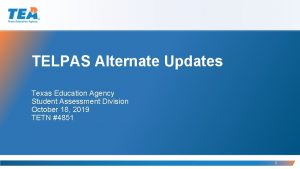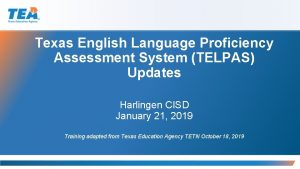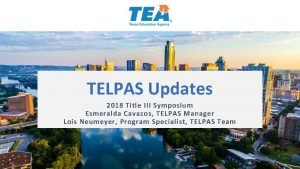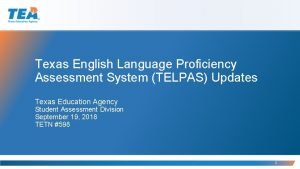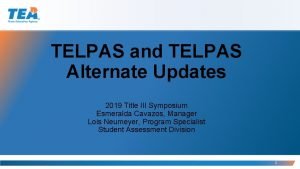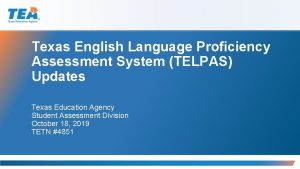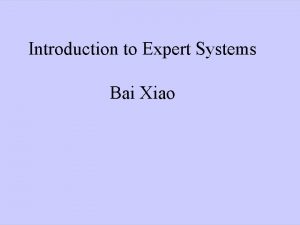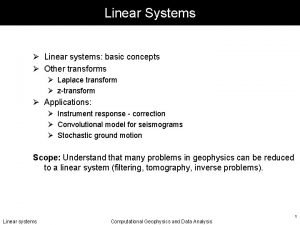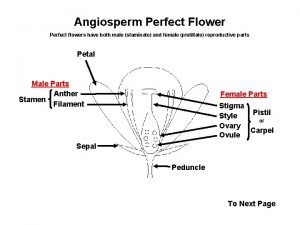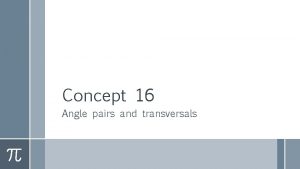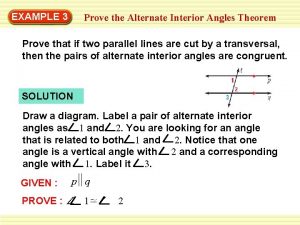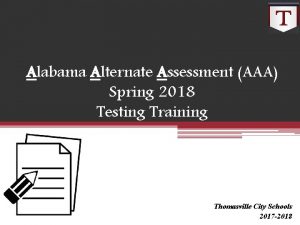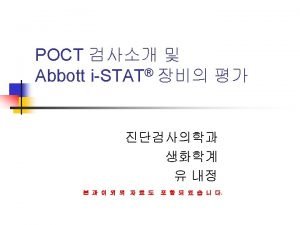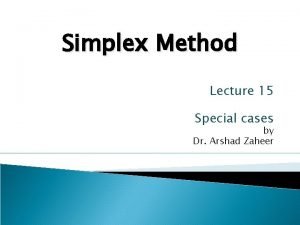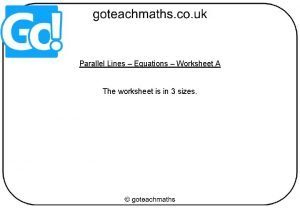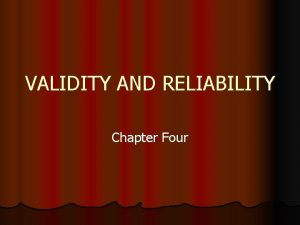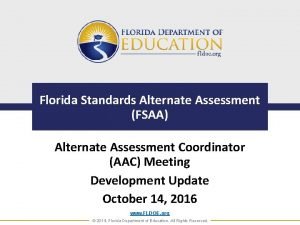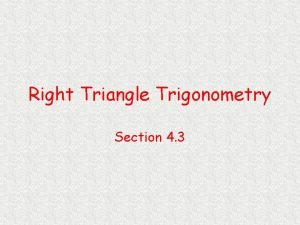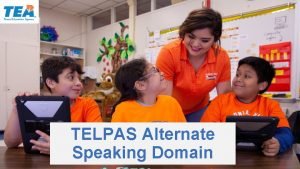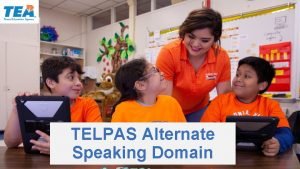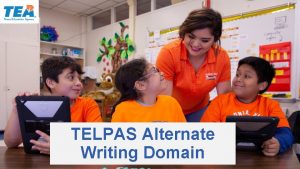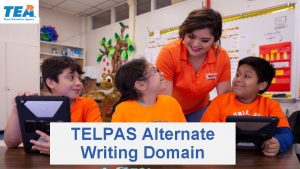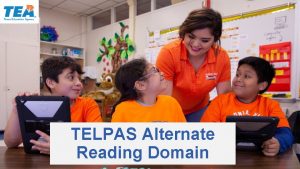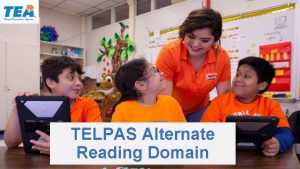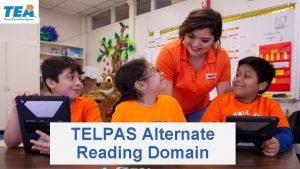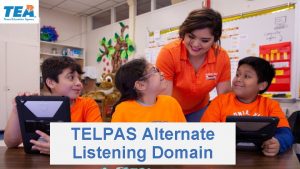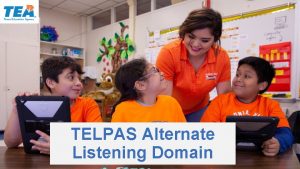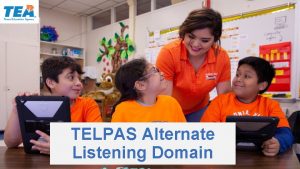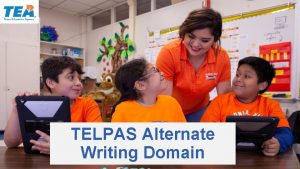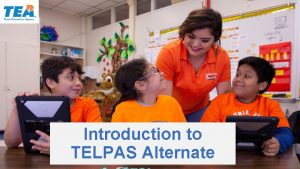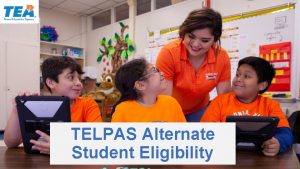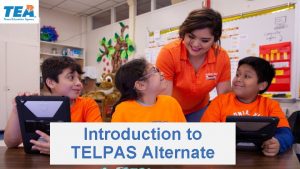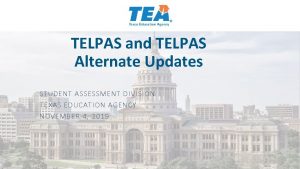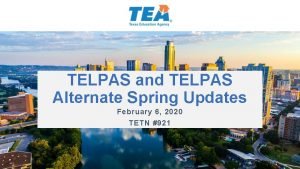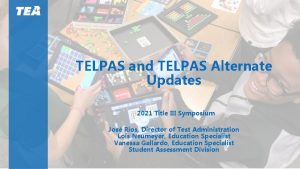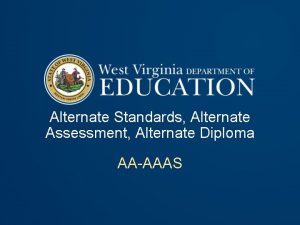TELPAS Alternate Speaking Domain Purpose of this TELPAS































- Slides: 31

TELPAS Alternate Speaking Domain

Purpose of this TELPAS Alternate Training • Intended for classroom teachers who will be administering TELPAS Alternate during the testing window § Can be used by others (e. g. , test coordinators, administrators, parents) as needed in order to clarify different aspects of this testing program • Explains the Alternate Proficiency Level Descriptors and Observable Behaviors for Speaking • Provides classroom examples of the Speaking Observable Behaviors • Describes ways to make the Speaking Observable Behaviors more accessible for students Texas Education Agency 2018 -2019 School Year 2

Alternate Proficiency Level Descriptors • TELPAS Alternate is a holistic inventory aligned to the Texas English Language Proficiency Standards (ELPS). • This inventory is based on alternate Proficiency Level Descriptors (PLDs) that were created to address the specific access needs of English learners with significant cognitive disabilities. • The PLDs can be used to better understand the intent and scope of specific Observable Behaviors. • The PLDs can be used to provide a summary of a student’s general English speaking ability after scoring. Texas Education Agency 2018 -2019 School Year 3

Alternate Proficiency Level Descriptors: Speaking Texas Education Agency 2018 -2019 School Year 4

What are Observable Behaviors? • In TELPAS Alternate, the Observable Behaviors are like questions the test administrator answers about a student. Each Observable Behavior measures one skill that is aligned to the ELPS. The skill can be found on the left under the number of the Observable Behavior. The boxes contain descriptions of characteristics that students learning English are likely to demonstrate over time. The descriptors show the progression of second language acquisition from one proficiency level to the next and are aligned to the TELPAS Alternate PLDs. • A “notes version” of the observable behaviors can be found on TEA’s TELPAS Alternate Resources web page. It is available so that educators can become familiar with the Observable Behaviors and practice using them during the school year. Texas Education Agency 2018 -2019 School Year 5

Observable Behaviors and the Glossary You may discover vocabulary in the Observable Behaviors that might be used in a way that differs from common classroom usage. The TELPAS Alternate Test Administrator Manual includes a glossary with terms specific to this assessment that may assist you. Texas Education Agency 2018 -2019 School Year 6

Observable Behaviors with Classroom Examples • Texas teachers developed classroom examples to help test administrators better understand the descriptions of student performance for each Observable Behavior. • Elementary and secondary examples describe one way that students could demonstrate each skill across the five levels of proficiency. Elementary Teacher retells “The Three Little Pigs” story. Student does not turn his head toward the teacher. Teacher retells “The Three Little Pigs” story. Student approximates the words “pig” and “wolf. ” Student uses pictures from “The Three Little Pigs” to communicate “pigs, ” “houses, ” “wolf, ” and “fall. ” Student independently produces “pigs build house” using a communication device when retelling the story “The Three Little Pigs. ” Student independently signs “the wolf, ” “huff, ” “puff, ” “straw house, ” and “blow down” when retelling the story using pictures. Secondary Student keeps eye gaze on “Life Cycle of Butterfly” book. Student uses gestures for “egg” and “butterfly” as the teacher retells the life cycle progression of a butterfly. Student independently points to the key words “pupa, ” “larvae, ” and “butterfly” to retell the life cycle of a butterfly. Student independently signs “lay an egg, ” “caterpillar eats, ” and “turns into butterfly” to retell the life cycle of a butterfly. Student uses a graphic organizer with transitional words as prompts to retell the life cycle of a butterfly. An accessible version of the Observable Behaviors and classroom examples can be found at https: //tea. texas. gov/student. assessment/telpasalt/#Alt Texas Education Agency 2018 -2019 School Year 7

Using the Classroom Examples • The purpose of each example is to illustrate how a student could demonstrate the skill at each proficiency level. • There are many other classroom activities that could be used as examples for the Observable Behaviors. • These examples are not intended to be used as test questions or performance tasks for teachers to replicate, although using them for this purpose is acceptable if needed. • Teachers are encouraged to use their own activities in the regular classroom setting when determining a student’s ability to understand use English. Texas Education Agency 2018 -2019 School Year 8

Observable Behavior S 1. Retelling Stories with Classroom Examples Elementary Teacher retells “The Three Little Pigs” story. Student does not turn his head toward the teacher. Teacher retells “The Three Little Pigs” story. Student approximates the words “pig” and “wolf. ” Student uses pictures from “The Three Little Pigs” to communicate “pigs, ” “houses, ” “wolf, ” and “fall. ” Student independently produces “pigs build house” using a communication device when retelling the story “The Three Little Pigs. ” Student independently signs “the wolf, ” “huff, ” “puff, ” “straw house, ” and “blow down” when retelling the story using pictures. Secondary Student keeps eye gaze on “Life Cycle of Butterfly” book. Student uses gestures for “egg” and “butterfly” as the teacher retells the life cycle progression of a butterfly. Student independently points to the key words “pupa, ” “larvae, ” and “butterfly” to retell the life cycle of a butterfly. Student independently signs “lay an egg, ” “caterpillar eats, ” and ”turns into butterfly” to retell the life cycle of a butterfly. Student uses a graphic organizer with transitional words as prompts to retell the life cycle of a butterfly. Texas Education Agency 9

Observable Behavior S 2. Classroom Communication with Classroom Examples Elementary Student looks around the classroom as the teacher names “desk” and “door. ” Teacher picks up and names a pencil. Student approximates “pencil. ” Student independently names “chair” and “desk” when asked to name items. Student independently signs “my desk” during a classroom discussion. Student independently produces “The round teacher table” and “little student desk” using a communication device. Secondary Student remains silent during an introduction to lab safety materials. Student tries to verbalize “goggles” after the teacher introduces and names the safety items. Student independently signs “tray” and “gloves” to name safety items. Student independently says “use first-aid kit” to communicate knowledge of lab safety. Student independently uses a communication device to produce “Goggles protect your eyes. Gloves keep your hands safe. ” Texas Education Agency 10

Observable Behavior S 3. Discussing with a Group with Classroom Examples Elementary Student changes facial expression during a group weather activity. Student uses gestures for “hot” and “cold” after teacher initiates the words during a group weather activity. Student independently points to the words “hot” and “sun” to describe the weather during a group weather activity. Student independently uses a communication device to produce “hot day” to describe the weather during a group weather activity. Student independently speaks the words “It is hot and sunny outside today” during a group weather activity. Secondary Student remains silent during a group discussion about the surface of Mars. Student imitates the word “red” after another student says “red” during a group discussion about the surface of Mars. Student independently says “red” and “Mars” during a group discussion about the surface of Mars. Student independently says “red dust there” to describe the surface of Mars during a group discussion. Student independently uses a communication device to produce the words “Mars is covered with red dust and old volcanoes” during a group discussion about the surface of Mars. Texas Education Agency 11

Observable Behavior S 4. Asking Questions with Classroom Examples Elementary Student demonstrates little facial expression while teacher introduces single-word questions with the answer, such as “Where? ” Student tries to imitate the word “where” when the teacher asks “Where do you live? ” Student independently pushes the button to activate “How are you? ” using a communication device during the morning meeting. Student independently signs “What are you eating? ” during lunch. Student independently asks for a friend’s opinion of a book during reading time. Secondary Student makes a vocalization to the teacher asking “What? ” Teacher asks a question during a literacy lesson. Student repeats the question word. Student independently signs “football game” to indicate “Are you going to the football game after school? ” to a friend. Student independently signs “Are you going? ” when talking about the football game. Student independently vocalizes “When was the Declaration of Independence written? ” during American History class. Texas Education Agency 12

Observable Behavior S 5. Giving Information with Classroom Examples Elementary Student demonstrates no change in facial expression when talking about birthdays. Teacher tells the class about a special birthday cake. Student imitates “cake” when asked to share a birthday experience. Student independently says “cake, ” “presents, ” and “balloons” when asked to share a birthday experience. Student says “birthday cake good” when asked to share a birthday experience. Student independently says “I got a new game for my birthday. ” Secondary Student does not eye gaze when teacher points to “Austin, Texas” on a map during a geography lesson. Student mimics the sign for “Austin” when the teacher signs “We live in Austin. ” Student independently presses buttons on a communication device to share the street and town where he lives. Student independently verbalizes “live in Lubbock” when asked where he lives. Student signs “I live in Austin, Texas, with my family. ” Texas Education Agency 13

Observable Behavior S 6. Expressing Opinions with Classroom Examples Elementary Student smiles when teacher is discussing a field trip to the zoo “being fun. ” Student activates a switch for “fun” after the teacher expresses that the “field trip will be fun. ” Teacher asks the student if the field trip will be fun or not fun. The student responds “It’s fun. ” Student independently signs “bus will be fun” in response to a question about whether the field trip will be fun. Student independently vocalizes “I think that the field trip will be fun. ” Secondary Student makes a vocalization when the teacher says “Good citizens vote. ” Student repeats “good” when the teacher says “Voting is a civic responsibility. It is good to vote. ” Student independently signs that he will vote for a particular candidate for student council when given the two choices. Student independently uses a communication device to produce “good citizen votes. ” Student independently says “I voted. I am a good citizen. ” Texas Education Agency 14

Observable Behavior S 7. Expressing Feelings with Classroom Examples Elementary Student smiles when teacher says “I feel happy today. ” Student approximates “happy” after teacher says “I feel happy today. ” Student makes a gesture for “happy” when the teacher asks “How do you feel? ” Student independently produces “feel sad now” on his communication device after his friend moved. Student independently verbalizes “I feel sad because my fish died” in response to a moment of silence. Secondary Student turns his head when teacher says “I am afraid of storms. ” Student makes a gesture for “afraid” when teacher signs “I am afraid of storms. ” Student independently produces “afraid” using his communication device when participating in a classroom discussion about storms. Student independently signs “feel angry. ” Student independently says “I am angry because I cannot go outside. ” Texas Education Agency 15

Observable Behavior S 8. Describing Objects with Classroom Examples Elementary Student does not look at the model of the circle during a lesson on shapes. Student approximates “circle” when the teacher holds up a model of a circle. Student independently signs “round” and “circle” to describe a clock face. Student independently says “like a circle” to describe a clock face. Student independently produces “The clock is round. It is a circle. ” Secondary Student vocalizes when the teacher holds up a box of crackers and describes the box. Student repeats the word “corner” when the teacher says that the box has 8 corners. Student makes a sign for “box” and “open” to describe the box of crackers. Student independently generates “open box of crackers. ” Student independently says “That box of crackers has 8 corners. One side can open. ” Texas Education Agency 16

Observable Behavior S 9. Explaining Tasks with Classroom Examples Elementary Student looks at the teacher, who is explaining how to sharpen a pencil. Student approximates “sharp” as the teacher is modeling how to sharpen a pencil. Student independently produces the words “pencil” and “sharpen” when the teacher asks what to do when the pencil lead breaks. Student independently says “make pencil point. ” Student independently says “First I put my pencil in the pencil sharpener. It makes a noise. I pull the pencil out to check it. ” Secondary Student eye gazes at the teacher as she explains how to transition to breakfast. Student tries to say “note” as the teacher checks his backpack asking for notes from home. Student independently produces “money” and “buy” when entering the classroom, indicating that he wants to buy a school T-shirt. Student independently says “time lunch” after morning work. Student independently says “It’s time to go home on the bus. I need my backpack” at the end of the day. Texas Education Agency 17

Observable Behavior S 10. Reacting to Media with Classroom Examples Elementary Student looks at the screen when morning announcements begin. Student repeats “good morning” after hearing the greeting while watching the morning announcements. Student independently says “pledge” when the morning announcements start. Student independently signs “do the pledge” while watching the morning announcements. Student independently produces “I say the pledge. I listen to the announcements. ” Secondary Student stares at the monitor during a virtual field trip to the art museum. Student imitates a greeting from the presenter to the class during a virtual field trip. Student independently produces “pretty” in response to seeing a painting during the virtual field trip. Student independently signs “go there” during a virtual field trip. Student independently says “I like looking at paintings. My favorite was the one of the flowers” after going on a virtual field trip. Texas Education Agency 18

How to Determine Student Proficiency for Each Observable Behavior 1. Test administrators should consider only one Observable Behavior at a time. 2. Test administrators will read the skill and think about recent opportunities the student has had to practice that skill. Then test administrators will read the five descriptions of student performance for the Observable Behavior and use their current knowledge and observations of the student’s English language skills to make individual holistic judgments. Texas Education Agency 2018 -2019 School Year 19

How to Determine Student Proficiency for Each Observable Behavior, continued 3. Test administrators must consider the ability of each EL to use English in the domain of speaking in the context of skills the student is learning and practicing in a classroom setting. § Think about how well the student has demonstrated the ability to understand or use English in the context of skills the student is learning. § Think about how well the student is able to understand or use English when practicing these skills in a classroom setting. 4. Select the description that closely matches the student’s performance most consistently. § Consistently: almost always acting, behaving, or responding in the same way Texas Education Agency 2018 -2019 School Year 20

On the Border • There is an early, a middle, and a late stage within each TELPAS Alternate proficiency level. Students in the early stage of a proficiency level might demonstrate language that drops down into the previous level at times, especially when working with academic language or new vocabulary and language structures. • Similarly, students in the late stage of a proficiency level will sometimes demonstrate language that reaches into the next level. • For each observable behavior, test administrators must consider the description that applies to each student most consistently. Demonstrating a new skill once or even occasionally does not mean a student has crossed over into a higher level of proficiency. Texas Education Agency 2018 -2019 School Year 21

Collaboration • For students who are in the very early or very late stage of a level, it is recommended that test administrators § collaborate with others or ask others familiar with the students for input, and § wait until later in the assessment window to see whether a couple of additional days of observation will help clarify the most appropriate description. Texas Education Agency 2018 -2019 School Year 22

Example of Rating a Student “On the Border”: Veronica Mr. Bane has been working with his student, Veronica, on the skill of “asking questions. ” Since the beginning of the year, she has been able to imitate the questions that he asks. Recently, however, he has started to notice that she is able to put a couple of words together and ask her own questions. Last week she asked “What lunch? ” to find out what was for lunch, and yesterday she asked a friend “Where going? ” Mr. Bane determines that Veronica is near the border between the second and third description for this Observable Behavior and wants to gather more information. He asks the speech therapist and an assistant in his room if they have observed Veronica asking simple questions, and he gives them some examples of what he has heard. They confirm that they are seeing the same behavior in their interactions with Veronica. Mr. Bane determines that Veronica is now consistently able to form simple questions with words that are highly familiar to her. For this Observable Behavior, he marks “C. ” 23

Example of Rating a Student “On the Border”: Omar • The TELPAS Alternate administration window is open. Ms. Hodge has been gathering information about one of her students, Omar. Ms. Hodge refers to some observations she has made this school year (see below). In her first note from November, she is reminded that Omar was not producing full detailed sentences. At that time, he was only using a small number of combined words. But she sees a difference beginning with her February note. Starting in February, Omar’s responses became more elaborate and complete. She determines that he is now able to share detailed personal experiences. 24

Alternate Response Modes • For TELPAS Alternate, “English” is more inclusive to allow for all modes of communication in English. • Some English learners use sign language, braille, or another method of communication as a substitute for traditional English in one or more language domains. • Test administrators should allow students to use one or more alternate response modes on the following slide if the students regularly use the response mode(s) during instruction and in accordance with the IEP. • Alternate response modes are only intended for students who cannot listen, speak, read, or write in a traditional way. They are intended to address the communication needs of students based on their disability. Texas Education Agency 2018 -2019 School Year 25

Allowable Response Modes for the Speaking Domain For the speaking domain, it is allowable for a student to § verbalize responses § form responses with the assistance of a communication device with preprogrammed familiar vocabulary or programmed student vocabulary § sign responses Texas Education Agency 2018 -2019 School Year 26

Augmentative and Alternative Communication • Augmentative and Alternative Communication: a means other than traditional spoken or written communication by which a student can share a message with others. • Examples include but are not limited to: § § § § gestures facial expressions picture cards picture boards sign language speech-generating devices switch-based output devices real objects Texas Education Agency 2018 -2019 School Year 27

Prompting Versus Leading • • • Prompting is an action intended to initiate or continue a task that the student is being requested to complete. A prompt pulls the student through each step to the end of the task. Leading is asking the student to respond in a specific way or with a specific answer. Leading is NOT allowed. Prompting is allowed for rating the Observable Behaviors on the TELPAS Alternate assessment. § The purpose of TELPAS Alternate is to accurately measure a student’s ability to understand use English to engage in social and academic learning environments. § Prompting a student to respond to a task so that his or her ability to understand or use English can be accurately measured is acceptable. Texas Education Agency 2018 -2019 School Year 28

Available TELPAS Alternate Training Power. Points q Introduction to TELPAS Alternate q Reading Domain q Writing Domain q Student Eligibility q Accessibility q Listening Domain q Test Administration q Speaking Domain Texas Education Agency 2018 -2019 School Year 29

Contact Information TEA’s Student Assessment Division 512 -463 -9536 assessment. specialpopulations@tea. texas. gov Pearson’s Customer Service Center 800 -627 -0225 Tx. Pearson. Access@support. pearson. com Texas Education Agency 2018 -2019 School Year 30

Disclaimer These slides have been prepared by the Student Assessment Division of the Texas Education Agency. You are encouraged to use them for local training. If any of the slides are changed for local use, please hide or remove any TEA logos, headers, or footers. (You may need to edit the Master slide. ) In addition, you must remove the photographs. Only TEA has parental permission to use these photographs for training purposes. This training is not intended to replace any materials or additional information on the TEA website. Texas Education Agency 2018 -2019 School Year 31
 Telpas alternate resources
Telpas alternate resources Telpas speaking rubric
Telpas speaking rubric Title iii symposium
Title iii symposium Telpas 4 point speaking rubric
Telpas 4 point speaking rubric Telpas 4 point speaking rubric
Telpas 4 point speaking rubric Telpas speaking rubric
Telpas speaking rubric Problem domain vs knowledge domain
Problem domain vs knowledge domain Domain and range games
Domain and range games Z transform of delta function
Z transform of delta function A_______ bridges the specification gap between two pls.
A_______ bridges the specification gap between two pls. S domain to z domain
S domain to z domain Z domain to frequency domain
Z domain to frequency domain Domain specific vs domain general
Domain specific vs domain general Fourier series of trapezoidal waveform
Fourier series of trapezoidal waveform Domain specific vs domain general
Domain specific vs domain general Common z transform pairs
Common z transform pairs What is a sentence purpose
What is a sentence purpose Chapter 5 selecting a topic and a purpose
Chapter 5 selecting a topic and a purpose Alternate opposite whorled leaves
Alternate opposite whorled leaves Alternate interior angles converse
Alternate interior angles converse In the figure m 3 = 102 find the measure of each angle
In the figure m 3 = 102 find the measure of each angle Alternate interior angles
Alternate interior angles Aaa assessment test answers
Aaa assessment test answers Alternate site testing
Alternate site testing Unbounded simplex method
Unbounded simplex method Missing angles in parallel lines
Missing angles in parallel lines Alternate interior angles
Alternate interior angles Alternate form of reliability
Alternate form of reliability Fsaa datafolio
Fsaa datafolio Csc in triangle
Csc in triangle Rima baciata
Rima baciata Vaap content area cover sheet
Vaap content area cover sheet
